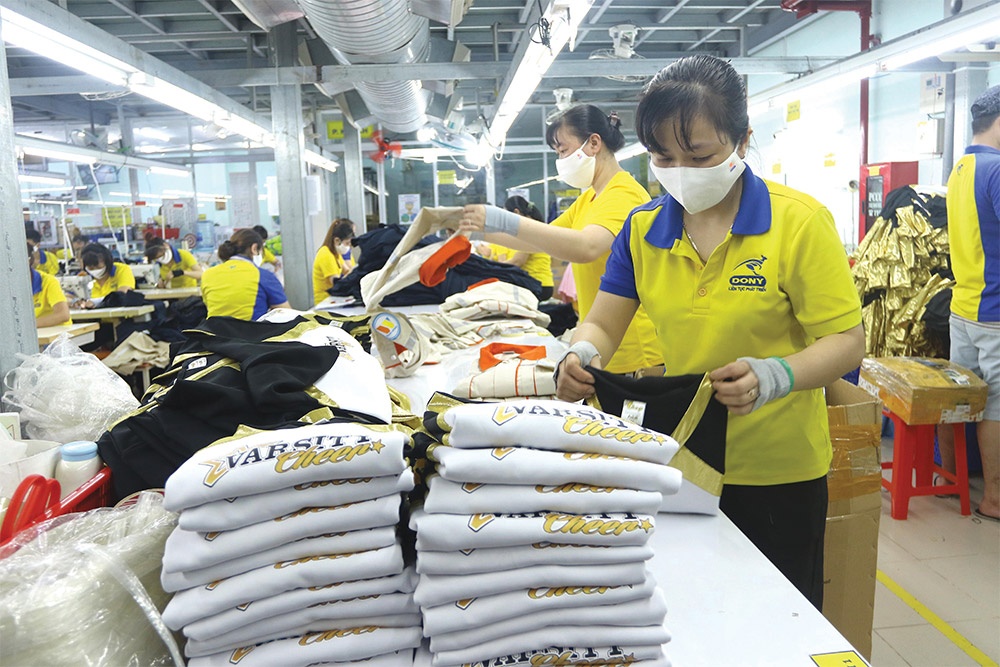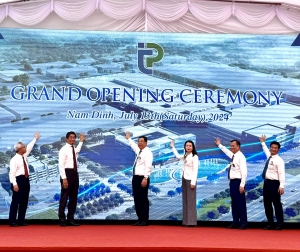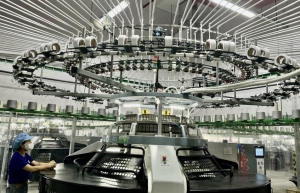Prejudices hold back garment investment
 |
| Fibre and sewing ecosystems on the chain have developed well, but dyeing and weaving are behind, photo Le Toan |
According to the Ministry of Industry and Trade, the textile and garment industry continues to record positive signals, with export turnover likely to exceed $45 billion in 2024. However, in recent times, the localisation rate of the textile and garment industry has only reached about 46-47 per cent.
With that, the ability to localise Vietnam’s textile and garment export products is not broad, and has not brought much added value to goods.
“Attracting foreign investment to develop the upstream sector and achieve production self-sufficiency in raw materials is of our goals, as well as in state management agency policies. But thus far, these targets have fallen short of expectations. The majority of raw materials needed by domestic textile and apparel companies to produce their goods still need to be imported,” said Vu Duc Giang, chairman of the Vietnam Textile and Apparel Association (VITAS).
The development strategy of Vietnam’s textile and garment industry to 2030, with a vision to 2035, is oriented from rapid development to sustainable development according to the circular economic model. The industry must complete the domestic value chain, participate in a high-value position in the global supply chain, and build Vietnam’s brand for export.
While the strategy, which calls for investment in the textile and dyeing industry to minimise the import of raw materials, is deemed fair, the problem lies in how to implement it, said Giang.
“Planning for industrial areas is one approach – Rang Dong Industrial Park is located only in the northern province of Nam Dinh, and it has attracted some Japanese investors. However, the majority of other communities and units are indifferent to the wastewater issue and do not care to plan for future development. This is a challenge,” Giang explained.
According to VITAS, the structure of Vietnam’s textile and garment industry is still unbalanced between production stages. About 60 per cent of enterprises are engaged in garment production, 17 per cent in fibre production, 14 per cent in fabric production, 5 per cent in raw material production, 2 per cent in towel production, and 2 per cent of other output.
The two stages at the beginning and end of the chain, fibre and sewing, have developed on a massive scale, while weaving and dyeing have been the bottlenecks of the industry for many years. Infrastructure for dyeing and fabric production is still limited.
Some localities have even rejected dyeing and weaving projects, claiming that this industry causes pollution, although investors have stated that they will use modern processing technology that will not negatively impact the environment. Therefore, to take advantage of the high added value from Vietnam’s free trade agreements, investing in the supply chain of the textile and garment industry is an urgent need of the Vietnamese textile and garment industry.
Than Duc Viet, general director of Garment Corporation 10, said that for the supporting industry, and especially in terms of raw materials, the bottleneck lies in the perception of management agencies in provinces and ministries about the prejudice that textiles and garments pollute the environment and cannot be treated.
“Obviously, if we invest sufficiently, we can treat all waste before discharging it into the environment to meet Vietnamese and international standards. There is no reason for us to think that investing in dyeing and weaving is polluting the environment because the technology now allows it,” said Viet.
He believes that the bottleneck will be resolved if the government has plans for dyeing and weaving production areas. “If we invest to a certain extent in wastewater treatment, then awareness of ministries and branches, as well as provinces and localities, will certainly help change the story of dyeing and weaving investment,” Viet said.
 | Garment orders rise but costs still surge Vietnam’s garments and textiles have witnessed a bright picture so far this year, but the remaining months could be difficult if the industry is to reach its annual target. |
 | Nam Dinh inaugurates its largest textile factory to date TOP Textile JSC held an inauguration ceremony for its $203 million textile and dyeing factory in the northern province of Nam Dinh on July 13, marking an important milestone for the company in Vietnam. |
 | High-tech garment groups keen to expand Vietnam has become a top destination for foreign investors in the high-tech garment and textile industry, contributing to restructuring the global value chain. |
 | Israeli textile firm to increase investment in Binh Dinh Israeli textile firm Delta Galil Industries will increase its investment from $64.6 million to $100 million to scale up its textile and garment project in the central province of Binh Dinh. |
What the stars mean:
★ Poor ★ ★ Promising ★★★ Good ★★★★ Very good ★★★★★ Exceptional
Related Contents
Latest News
More News
- Businesses ramp up production as year-end orders surge (December 30, 2025 | 10:05)
- Vietjet chairwoman awarded Labour Hero title (December 29, 2025 | 13:06)
- How to unlock ESG value through green innovation (December 29, 2025 | 10:03)
- AI reshapes media and advertising industry (December 29, 2025 | 08:33)
- FPT and GELEX sign deal to develop blockchain tech for global markets (December 29, 2025 | 08:29)
- Vietnam’s GDP forecast to grow by 9 per cent in 2026 (December 29, 2025 | 08:29)
- Women entrepreneurs are key to Vietnam’s economic growth (December 29, 2025 | 08:00)
- Vietnam's top 500 value-creating enterprises announced (December 27, 2025 | 08:00)
- The PAN Group shaping a better future with ESG strategy (December 26, 2025 | 09:00)
- Masan Consumer officially lists on HSX, marking the next phase of value creation (December 25, 2025 | 13:20)

 Tag:
Tag:




















 Mobile Version
Mobile Version